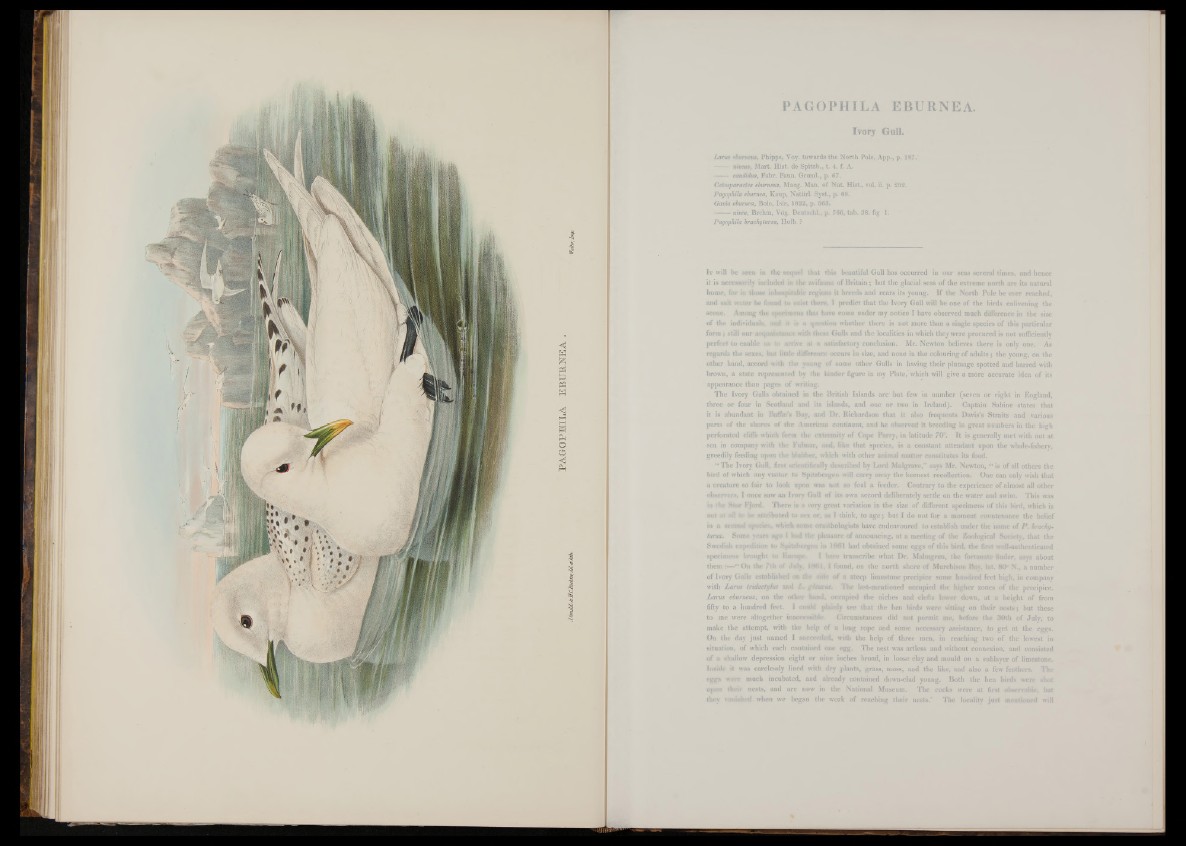
P A G O P H I L A E B U R N E A .
PAGOPHILA EBURNEA.
Ivory Gull.
Larus "i;ir/was, Phipps, Voy. towards the North Pole, App., p. 187.'
niveus, Mart. Hist, de Spitzb., t. 4. f. A.
candidus, Fabr. Faun. Groenl., p. 67.
Cetosparactes ebarneus, Macg. Man. of Nat. Hist., vol. ii. p. 252.
Pagophila ehurnea, Kaup, Natiirl. Syst., p. 69.
Gavia ebumea, Boie, Isis, ) 822, p. 663.
nivea, Brehm, Yög. Deutsch!., p. 766, tab. 38. fig 1.
Pagophila brachytarsa, Holb ?
It will be seen in the sequel that this beautiful Gull has occurred in our seas several times, and hence
it is necessarily included in the avifauna o f Britain; but the glacial seas o f the extreme north are its natural
home, for in those inhospitable regions it breeds and rears its young. If the North Pole be ever reached,
and salt water be found to exist there, I predict that the Ivory Gull will be one o f the birds enlivening the
scene. Among the specimens that have come under my notice I have observed much difference in the size
of the individuals, swmI <t is a question whether there is not more than a single species o f this particular
form; still our acquañttance with these Gulls and the localities in which they were procured is not sufficiently
perfect to enable us to arrive a» a satisfactory conclusion. Mr. Newton believes there is only one. As
regards the sexes, but little difference occurs in size, and none in the colouring o f adults; the young, on the
other hand, accord with the young of some other Gulls in having their plumage spotted and barred with
brown, a state represented by the hinder figure in my Plate, which will give a more accurate idea o f its
appearance than pages o f writing.
The Ivory Gulls obtained in the British Islands are- but few in number (seven or eight in England,
three or four in Scotland and its islands, and one or two in Ireland). Captain Sabine states that
it is abundant in Baffin’s Bay, and Dr. Richardson that it also frequents Davis’s Straits and various
parts o f the shores o f the American continent, and he observed it breeding in great numbers in the high
perforated cliffs which form the extremity o f Cape Parry, in latitude 70°. It is generally met with out at
sea in company with the Fulmar, and, like that species, is a constant attendant upon the whale-fishery,
greedily feeding upon the blabber, which with other animal matter constitutes its food.
“ The Ivory Gull, first scientifically described by Lord Mulgrave,” says Mr. Newton, “ is o f all others the
bird of which any visitor to Spitzbergen will carry away the keenest recollection. One can only wish that
a creature so fair to look upon was not so foul a feeder. Contrary to the experience o f almost all other
observers, I once saw an Ivory Gull of its own accord deliberately settle on the water and swim. This was
in the Sum- Fjord. There is a very great variation in the size o f different specimens o f this bird, which is
not at ad to be attributed to sex or, as I think, to a g e ; but I do not for a moment countenance the belief
in a seeond species, which some ornithologists have endeavoured to establish under the name o f P . brachy-
tarsa. Some years ago I had the pleasure o f announcing, at a meeting o f the Zoological Society, that the
Swedish expedition to Spitzbergen in 1861 had obtained some eggs o f this bird, the first well-authenticated
specimens brought to Lamp«-. I here transcribe what Dr. Malmgren, the fortunate finder, says about
them :—“ On the 7th of duly. 1801, } found, on the north shore o f Murchison Roy, lat. 80° N., a number
of Ivory Gulls established on the s«ie o f a steep limestone precipice some hundred feet high, in company
with Larus tridactylus and glatteus. The last-mentioned occupied the higher zones o f the precipice.
Larus eburneus, on the other band, occupied the niches and clefts lower down, at a height o f from
fifty to a hundred feet. I could plainly see that the hen birds were sitting on their nests; but these
to me were altogether inaccessible. Circumstances did not permit me, before the 30th o f July, to
make the attempt, with the help o f a long rope and some necessary assistance, to get at the eggs.
On the day just named I succeeded, with the help o f three men, in reaching two o f the lowest in
situation, o f which each contained one egg. The nest was artless and without connexion, and consisted
o f a shallow depression eight or nine inches broad, in loose clay and mould on a sublayer o f limestone.
Inside it was carelessly lined with dry plants, grass, moss, and the like, and also a few feathers. The
eggs were much incubated, and already contained down-clad young. Both the hen birds were shot
upon the»* nests, and are now in the National Museum. The cocks were at first observable, but
they vanished, when we began the work o f reaching their nests.’ The locality just mentioned will